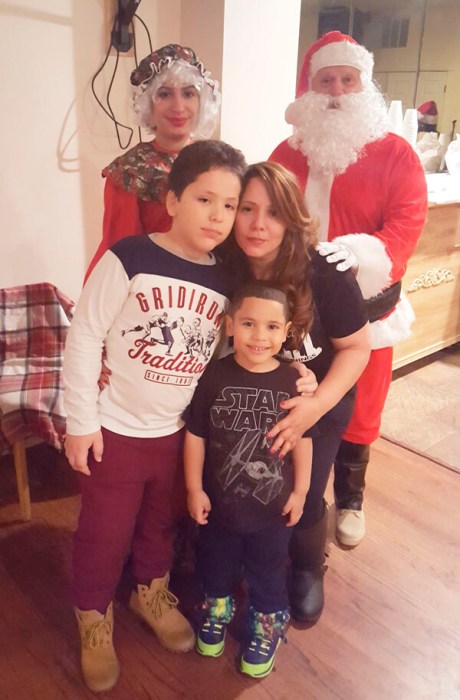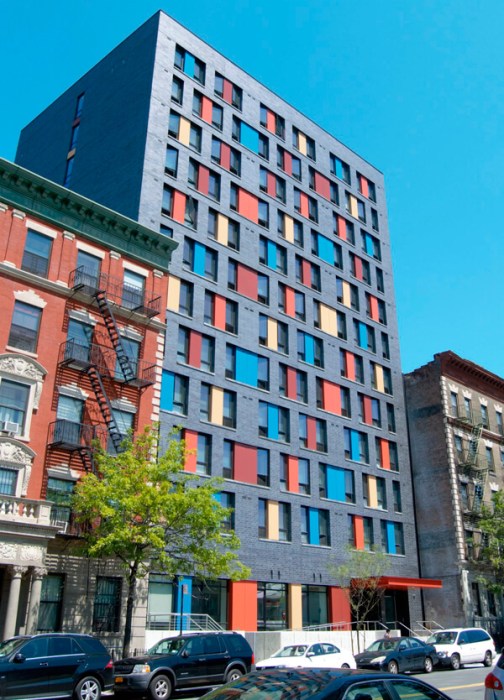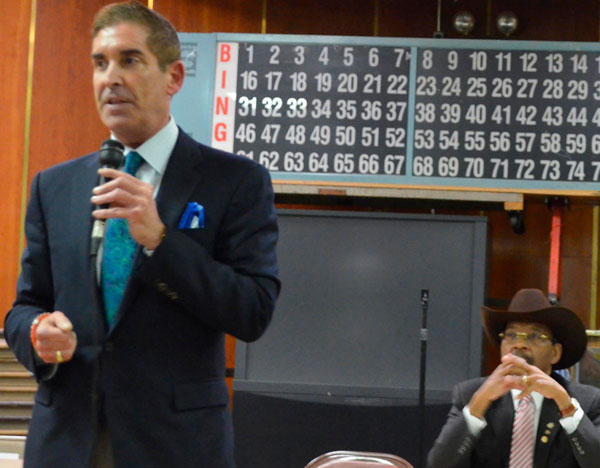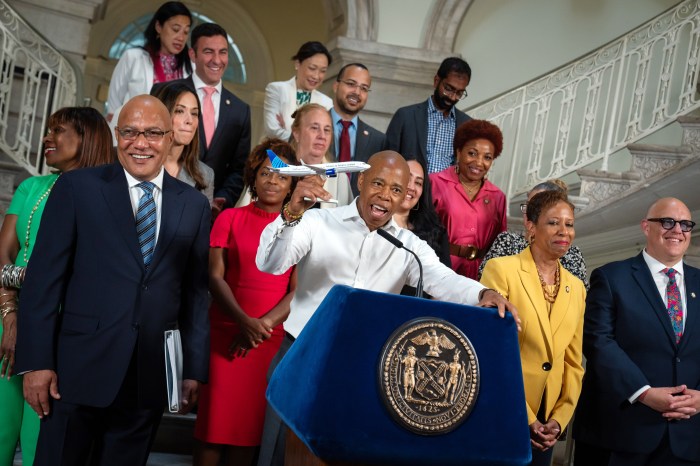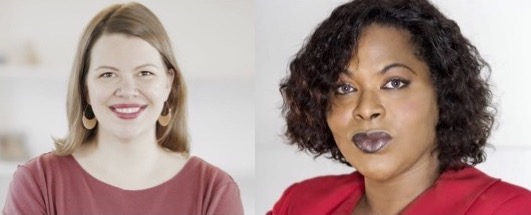When 68-year-old Demetrio Rivera stepped into his 14th-floor apartment at 112 E. Clarke St. — a $68.3 million senior housing facility located in the Jerome Avenue Highbridge-Concourse area of the Bronx — Rivera was home.
Rivera, who has been homeless for the past five years, broke in his new residence on June 24 by opening every cabinet drawer, admiring the size of his twin bed, and gazing outside the window that has an accompanying view of the New York City skyline and Yankee Stadium in the distance.
“I couldn’t ask for much more than this,” Rivera told the Bronx Times. “I remember sleeping on roofs, sleeping on street corners and panhandling … But I’m proof that things can get better and that you can never lose hope.”
Rivera is one of 46 tenants who have moved into the East Clarke Place Senior Residence over the past few weeks. The 14-story, 122-unit complex features 84 apartments designated for low-income seniors, with an additional 37 units assigned to chronically homeless seniors like Rivera.
Tenants must be at least 62 years old and earn 60% or less of the local area’s median income to be accepted as residents at East Clarke Place.
Volunteers of America-Greater New York officials said they received more than 26,000 applications for the 84 apartments and room assignments had been processed through a random lottery.
Additionally, 50% of the units are set aside for residents of the Bronx Community Board 5.
Officials from Volunteers of America-Greater New York hope that housing projects like East Clarke Place can be the first step toward eradicating homelessness in the Greater New York area by 2050.
“Homelessness doesn’t need to be an evergreen issue,” said Myung J. Lee, president and CEO of Volunteers of America-Greater New York. “We’re an anti-poverty organization that aims to get rid of homelessness … through three steps — housing, generational wealth-building and providing services to address mental and physical health.”
A grant from the state Department of Health Empire State Supportive Housing Initiative (ESSHI) helps provide rent subsidies for five years — $925,000 annually — for the 37 incoming seniors who are considered low-income and chronically homeless.
“Homelessness can’t be solved by just one step, it involved a strong support system which includes financial stability, autonomy over finances, and decision-making and there are systems in place here to ensure that the seniors living here won’t be without support,” said Rachel Weinstein, vice president of communications for Volunteers of America-Greater New York.
According to Coalition for the Homeless, in April 2021, there were 53,199 homeless people, including 16,390 homeless children, sleeping each night in the New York City municipal shelter system. The Coalition for the Homeless estimates that the amount of people experiencing homelessness in the city has reached its highest levels since the Great Depression.
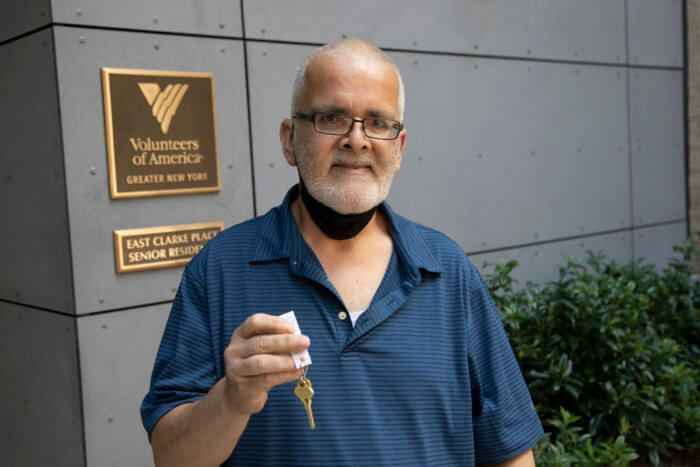
New York ranks second in the nation both in number and per-capita homelessness, outpaced only by California.
A concerning trend that has been on the rise is homelessness amongst senior citizens in the city.
According to research funded by New York State Health Foundation, the number of shelter residents age 50 and older in New York City topped 17,000 in 2017, and that number is expected to triple by the end of the decade in 2030.
Data from the NYC Center for Innovation through Data Intelligence reported that the number of homeless individuals in shelters age 55 and up increased by about 250% from 2004 to 2017, and the number of homeless individuals age 65+ increased over 300% during the same time period.
“Homelessness can happen suddenly, whether it’s a medical emergency that breaks the bank or losing a job and being unable to pay rent, homelessness can happen to anyone,” said Weinstein. “And we’re particularly concerned about older adults, so we’ve put a lot of significant resources into developing housing specific for this population because a number of people are living in housing that is completely inappropriate for these circumstances.”
The factors that lead to a person experiencing homelessness can vary, but the National Law Center on Homelessness & Poverty indicates five main causes of homelessness: lack of affordable housing, unemployment, poverty, mental illness and substance abuse.
Rivera held a steady job for nearly two decades working maintenance for the city Department of Education and had a permanent home with his mother before her passing. Following her death, Rivera found himself in and out of work in the subsequent years before being evicted.
When he was in his 3o’s, Rivera received a mental health diagnosis, and without substantial mental health services, he began using drugs.
“I have regrets. We all do,” he said. “But I can only look forward now and make better choices.”
While Rivera eventually became sober, he still struggled with homelessness and knew he would need help if he wanted to maintain his sobriety. He entered the city’s shelter system last year and was referred to Volunteers of America-Greater New York.
“It’s being treated as a human being, instead of being looked down upon,” Weinstein said. “I think that’s one of the things we all do at VOA, is that we aren’t judgmental. We’re here to say ‘hey, let’s do it together and do everything we possibly can [to achieve the goals set].”
A key step in the relationship between Volunteers of America-Greater New York and the clients experiencing homelessness is to establish an independent living plan that is “specific to the individual and may include paths to housing, education, employment, life skills development, budgeting, or securing benefits,” according to VOA officials.
The path to housing includes emergency shelter locations and transitional housing, with more permanent options being permanent supportive housing, with an end goal of sustainable, affordable housing.
Due to land scarcity and high construction costs, Lee said that there is an uphill battle for constructing complexes like East Clarke Place throughout the city. However, Lee believes that with “all eyes on New York,” the work done to address homelessness can be a model for peer cities.
“I think [Greater New York] is a great experiment to try and design buildings and living spaces that could possibly take care of the many New Yorkers who are experiencing homelessness,” Lee added. “All eyes are on New York City, and if we can accomplish this goal, I think it can set an example for other cities and communities when it comes to addressing homelessness and poverty.”
A central purpose of the East Clarke Place Senior Residence, according to Brian Moriarty, assistant vice president of behavioral health and senior housing programs for Volunteers of America-Greater New York, is to foster a community environment for new tenants, especially those who came from the isolated settings of shelter homes.
The layout of the East Clarke building is intentional with laundry rooms on alternating floors next to comfortable lounges to help encourage socializing, various outdoor areas to encourage group exercise and activities like art therapy, gardening, trips to museums or fitness classes tailored to older adults.
“There are community rooms, we have some outdoor patios for the potential to do group yoga and group exercises and build an active community that a lot of these seniors may have not had in the shelters,” he said.
And a sense of community has always been important to Rivera.
Volunteers of America-Greater New York staff said that Rivera was always willing to lend a hand to residents at the Schwartz Assessment Shelter where he was previously housed, often urging members to go to treatment, attend meetings and never lose hope, despite their situation.
“I would tell the guys to take it easy, don’t feel like nothing’s happening, and do one part at a time,” Rivera said. “Don’t feel like there’s no hope. Ask for help and reach out, and it will happen.”
As Rivera enters a new chapter in his life, his goals include reuniting with his brother for lunch, integrating into his new Jerome Avenue-Grand Concourse community and eventually, finding stable employment.
But he will continue to visit his former community at the Schwartz Assessment Shelter, he said, and hopefully, use his story as a motivation for others experiencing homelessness to find their permanent home.
“You know I’m not going to say everything was beautiful, but everything worked out,” he said, reflecting on his journey. “There’s a lot of good people down in the shelter, they are good people and I believe everyone deserves a chance.”

















